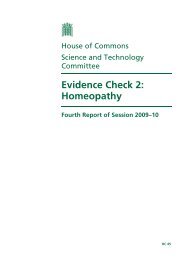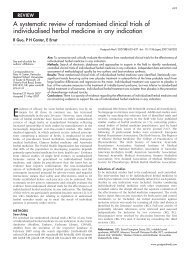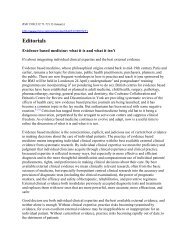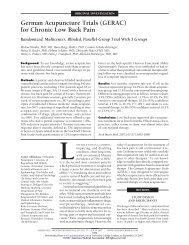Sacks et al., 2009
Sacks et al., 2009
Sacks et al., 2009
- No tags were found...
Create successful ePaper yourself
Turn your PDF publications into a flip-book with our unique Google optimized e-Paper software.
The new england journ<strong>al</strong> of medicineA All Participants0.0Protein Fat CarbohydrateChange in Weight (kg)−0.5−1.0−1.5−2.0−2.5−3.0−3.5−4.0−4.5−5.0Difference, −0.6(95% CI, −1.6 to 0.4)P=0.22High protein, fat, or carbohydrateDifference, 0.04(95% CI, −0.9 to 1.0)P=0.94Difference, 0.6(95% CI, −0.8 to 1.9)P=0.42Low or average protein, fat, or carbohydrateB Participants Who Compl<strong>et</strong>ed the StudyProtein Fat Carbohydrate0.0Change in Weight (kg)−0.5−1.0−1.5−2.0−2.5−3.0−3.5−4.0−4.5−5.0Difference, −0.9(95% CI, −2.1 to 0.2)P=0.11Difference, 0.2(95% CI, −1.0 to 1.3)P=0.76Difference, 0.7(95% CI, −0.9 to 2.3)P=0.37C All Participants0Protein Fat CarbohydrateChange in Waist Circumference (cm)−1−2−3−4−5−6−7Difference, −0.7(95% CI, −1.7 to 0.4)P=0.22Difference, 0.0(95% CI, −1.0 to 1.0)P=0.99Difference, 0.7(95% CI, −0.8 to 2.1)P=0.39D Participants Who Compl<strong>et</strong>ed the StudyProtein Fat Carbohydrate0Change in Waist Circumference (cm)−1−2−3−4−5−6−7Difference, −1.1(95% CI, −2.3 to 0.2)P=0.10Difference, 0.0(95% CI, −1.3 to 1.2)P=0.95Difference, 1.0(95% CI, −0.7 to 2.8)P=0.24Figure 1. Mean Change in Body Weight and Waist Circumference from Baseline to 2 Years According to Di<strong>et</strong>ary Macronutrient Content.Solid bars represent high-protein, high-fat, or highest-carbohydrate di<strong>et</strong>s. Open bars represent average-protein, low-fat, or lowest-carbohydratedi<strong>et</strong>s. T bars indicate standard errors. ICMPanels A and C show the change in body weight and the change in waist circumference,AUTHOR: <strong>Sacks</strong>RETAKE 1stREG F FIGURE: 1 of 42ndrespectively, for <strong>al</strong>l participants who were randomly assigned to a di<strong>et</strong> (a tot<strong>al</strong> of 811); missing 3rddata were imputed. A tot<strong>al</strong> of 403 participantswere assigned to a high-protein di<strong>et</strong> and CASE 408 to an average-protein di<strong>et</strong>, 405 were Revised assigned to a high-fat di<strong>et</strong> and 406 to a low-fatdi<strong>et</strong>, and 204 were assigned to the highest-carbohydrate EMailLine 4-CSIZEARTIST:di<strong>et</strong>tsand 201 to the lowest-carbohydrate di<strong>et</strong>. Panel B shows the change in bodyH/T H/Tweight for the 645 participants who provided Enon measurements at 2 years. 36p6ComboOf these participants, 325 were assigned to a high-protein di<strong>et</strong>and 320 to an average-protein di<strong>et</strong>, 319 were assigned to a high-fat di<strong>et</strong> and 326 to a low-fat di<strong>et</strong>, and 169 were assigned to the highestcarbohydratedi<strong>et</strong> and 168 to the lowest-carbohydrate Figure di<strong>et</strong>. has been Panel redrawn D shows and type the has change been res<strong>et</strong>. in waist circumference for the 599 participantsAUTHOR, PLEASE NOTE:who provided measurements at 2 years. Of these participants, Please 303 check were carefully. assigned to a high-protein di<strong>et</strong> and 296 to an average-proteindi<strong>et</strong>, 292 were assigned to a high-fat di<strong>et</strong> and 307 to a low-fat di<strong>et</strong>, and 159 were assigned to the highest-carbohydrate di<strong>et</strong> and 155 tothe lowest-carbohydrate di<strong>et</strong>.JOB: 36009 ISSUE: 02-26-09signed to a di<strong>et</strong> and those who compl<strong>et</strong>ed the study(Table 1).Weight LossThe amount of weight loss after 2 years was similarin participants assigned to a di<strong>et</strong> with 25%protein and those assigned to a di<strong>et</strong> with 15%protein (3.6 and 3.0 kg, respectively; P = 0.22) andamong those who compl<strong>et</strong>ed each of those di<strong>et</strong>s(4.5 and 3.6 kg, respectively; P = 0.11) (Fig. 1). Weightloss was the same in those assigned to a di<strong>et</strong> with40% fat and those assigned to a di<strong>et</strong> with 20% fat(3.3 kg, P = 0.94) and was similar among those whocompl<strong>et</strong>ed each of those di<strong>et</strong>s (3.9 and 4.1 kg, respectively;P = 0.76). There was no effect on weightloss of carbohydrate level through the targ<strong>et</strong> rangeof 35 to 65% (Fig. 1 and 2). The change in waistcircumference did not differ significantly amongthe di<strong>et</strong> groups (Fig. 1 and 2).Most of the weight loss occurred in the first864n engl j med 360;9 nejm.org february 26, <strong>2009</strong>Downloaded from www.nejm.org on March 14, <strong>2009</strong> . For person<strong>al</strong> use only. No other uses without permission.Copyright © <strong>2009</strong> Massachus<strong>et</strong>ts Medic<strong>al</strong> Soci<strong>et</strong>y. All rights reserved.











